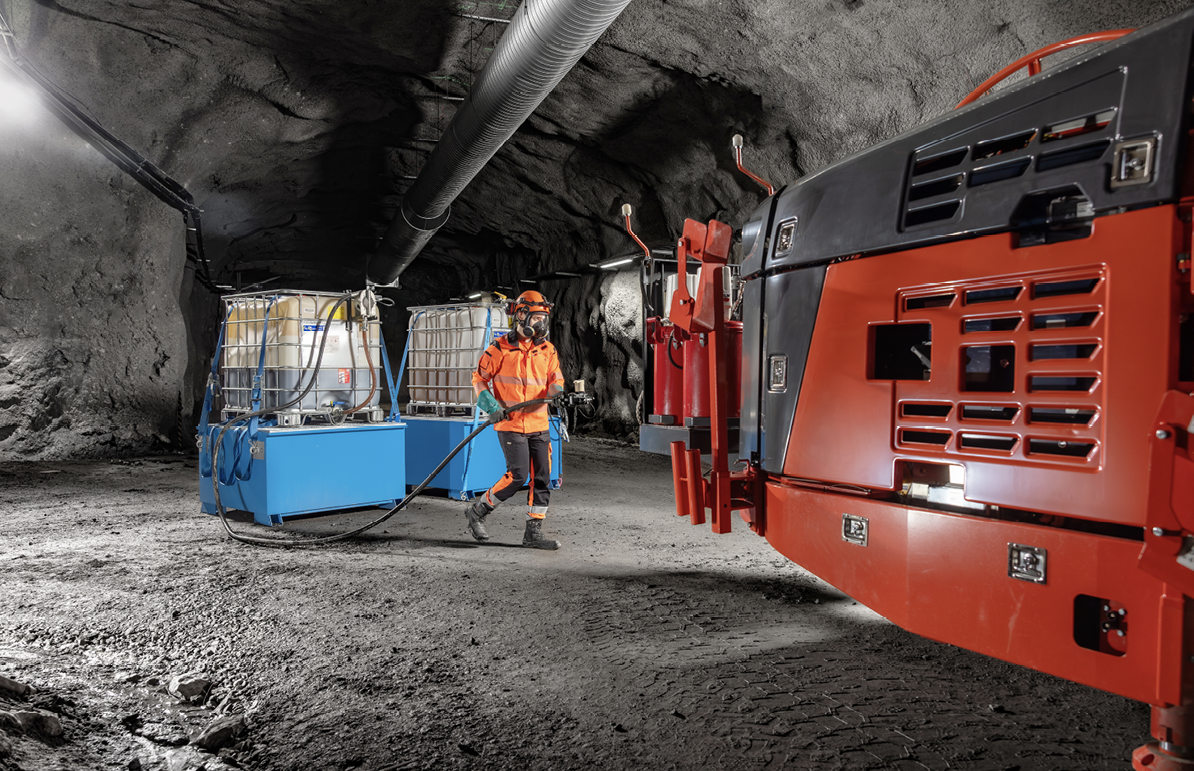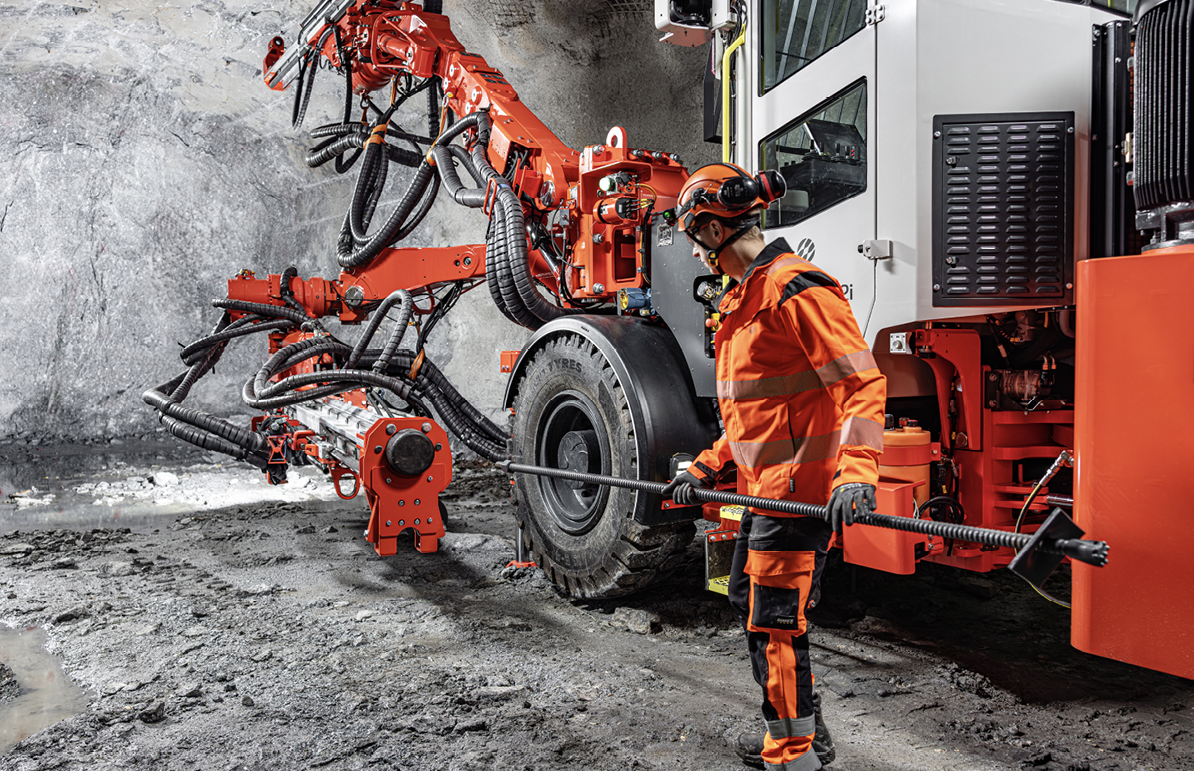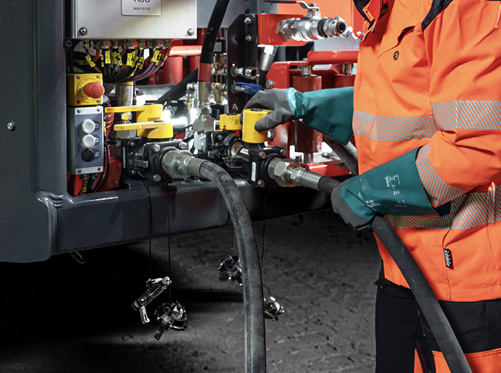Equipment and technology innovations offer the potential for faster, safer, and more accurate ground control; however, this should not come at the expense of a proper geotechnical understanding.
by Jonathan Rowland

of geotechnical risks, supported by innovative equipment and technology, to solve.
Pictured: Sandvik DD422i dual-control jumbo development drill with Mineral Bolt resin.
As underground operations move deeper and face increasingly complex conditions, equipment development is focused on delivering faster, safer, and more consistent ground control. Meanwhile, advances in computer processing capabilities drive the application of newer methodologies for geotechnical analysis, such as numerical modeling and artificial intelligence applied to geotechnical analysis, design, and risk evaluation. Amid the push for innovation, however, “a proper understanding of the geotechnical principles and theory behind modern tools remains paramount for realistically assessing risk,” Diego Negrete, senior consultant (rock mechanics) at SRK Denver, told North American Mining.
New technologies and geotechnical risk management
Negrete pointed to one of the most common tasks for ground control engineers – evaluating the stability of an underground pillar – as an example where there can be an “almost reflexive response to jump into numerical modelling and AI tools, particularly for recent engineering graduates.”
Although not “inherently bad practice”, Negrete continued, “the concern arises when the empirical analysis gets set aside, especially when there is not a proper data set and assumptions are made.” For instance, if there is a lack of understanding of the problem and how to solve it, selecting what numerical analysis is most suitable for the ground conditions is a challenge. “Several software programs are available that can assist with performing geotechnical numerical modelling, but not all work in the same way.”
According to the SRK consultant, several key questions should be evaluated when considering an AI application, such as machine learning. Is the expected material behavior elastic or plastic? Is a finite element or a discrete element method better for the analysis at hand? There is also the fact that “most tools or methods require calibration before use by an engineer with proper training and practical experience.” Lastly, any technology should be considered “only as a tool to facilitate a job. Like any tool, they are not going to solve the problem by themselves.”

Understanding the early value of geotechnical risk assessment
Negrete also noted that many projects “consider geotechnical input as optional, depending on the project’s nature and size, as well as the regional industry culture, while others, even some considered modern, don’t have a proper and formal basic geotechnical database to support the project and/or operation.” There are several related reasons behind this.
“Geotechnical engineering can be difficult to visualize, while its impact can be hard to appreciate,” explained Negrete. “This is because often all related analysis is done in the background. Only when an unplanned event happens is the value of geotechnics seen. The biggest impact of geotechnical analysis can have is thus for risk prevention, which is why it’s easy to overlook – until it’s too late.”
Training can help counter this. This extends beyond ensuring that geotechnical engineering is represented in a mine’s technical services team to include the miners themselves, as “they are the ones with the highest risk exposure,” Negrete said. “Ground control in an underground mine can be a massive task; thus, geotechnical risk management must become part of the assignments for all workers. This is another crucial reason to provide proper training: each person who understands geotechnical risks and how to identify them becomes an additional asset in the project’s geotechnical monitoring efforts.”
Don’t overlook the importance of well-trained and experienced personnel
Although modern tools and methodologies help engineers perform geotechnical analysis, design, and risk evaluation more efficiently, it is “essential not to overlook the engineering foundation and practices underlying them,” concluded Negrete. “Software and newer technologies like AI are excellent tools that facilitate geotechnical analysis and risk management, but even more importantly, proper geotechnical guidance through well-trained and experienced personnel is more effective in reducing the human error factor that will be present in the use of any tool or technology.”
Supporting miners to mine better: a look at new ground control equipment
Speaking about those at the rock face, some recent equipment developments from J.H. Fletcher and Sandvik have focused on making miners’ jobs safer and more productive.
J.H. Fletcher’s HV-32 drill head
West Virginia-based equipment supplier J.H. Fletcher & Co. has introduced its HV-32 drill head for roof bolting applications, particularly in challenging environments with hard-to-penetrate rock formations.
Part of the well-known Cannon product lines purchased from Trident Maritime Systems’ Heavy Equipment Group (formerly Lake Shore Systems), the HV-32 drill head has been designed for efficiency and reliability with a low-frequency, high-impact percussion cycle that significantly reduces drilling time and operational costs, Kayla Yaeger, J.H. Fletcher’s marketing coordinator, told North American Mining. It is available on new roof bolters and for retrofit on existing equipment.
“With proven success in coal, limestone, and salt mines, the HV-32 exemplifies our commitment to durable and cost-effective solutions, making it an invaluable tool for operations dealing with hard strata like granite,” concluded Yaeger.

A new pumpable resin system from Sandvik
Sandvik’s new pumpable resin system, featuring the company’s Ground Support Mineral Bolt technology, is now available for its DD422i and DD442iE dual-control jumbo development drills. This innovation “delivers a safer, faster, and more consistent bolting process to meet the increasingly complex demands of today’s underground mining,” said Daria Fuerstenau, business line manager – ground support. “Retrofittable pumpable resin kits are also available, enabling integration into existing machines already in operation.”
According to Fuerstenau, the new pumpable system uses a two-component, organic and mineral resin engineered for high strength and reliability. It firmly fixes mechanical bolts or anchors within boreholes, stabilizes heavily cracked rock masses, seals against gas penetration, and stops water inflows.
This solution now supports three major bolt types:
- Resin-grouted rebar bolts for high productivity at the lowest unit cost.
- Versabolt™ bolts, offering high energy absorption in dynamic ground support.
- DSI hollow-bar and self-drilling bolts, allowing post-grouting installation for peak productivity and safety, even in difficult
ground. Ideal for deep mining, block caving, and rehabilitation works.
“With the new pumpable resin package for dual controls, we are transforming bolt installation,” said Anssi Kouhia, ground support product manager at Sandvik. “It is faster, safer, and more consistent, giving operators full control and confidence underground.”
The system is designed with “a focus on operator safety and automation, featuring bolt loading from a safer working area, fast and mechanized resin injection via the operator display, and enhanced safety protections, including boom movement prevention, access barriers, and clear status indicators,” continued Kouhia. “Together, these upgrades enable bolting operations to be executed more efficiently and with reduced operator exposure.”
The DD422i dual-controls configuration uses the left boom for drilling and the right boom for resin bolting, allowing for sequential drilling and bolting without requiring equipment changes. This setup increases advance rates while improving cycle time efficiency. The resin tank system is installed at the machine’s rear frame. Although this increases the machine’s total length and alters its cornering capabilities, it brings significant operational benefits. The resin pumping and grouting process is fully controlled through the onboard operator display, where two flow meters monitor the resin ratio, which defaults to 50/50 and can be adjusted. The speed of the grout pipe is also adjustable based on the hole diameter, ensuring optimal filling.
Supporting this system is Sandvik’s Ground Support Mineral Bolt resin, a “high-performance solution developed for mechanized and automated applications,” said Kouhia. “The Mineral Bolt resin eliminates manual mixing errors, leading to more reliable fortification. Its rapid reaction time and fast curing significantly reduce delays associated with traditional cement-based grouting, helping operators maintain continuous production schedules. It is also available in multiple formulations, offering adjustable setting times and varying thixotropy levels to suit a wide range of underground conditions. Its adaptability makes it effective across a broad temperature range and helps ensure performance consistency in diverse environments.”
Another key advantage is its performance in difficult ground or soil conditions. “The thixotropic formulation prevents unwanted resin flow into surrounding fractures, concentrating the material where it is most needed to reinforce structural integrity, Kouhia explained. “As a result, Mineral Bolt resin improves overall ground stability and extends the life of underground excavations.”
Together, the pumpable resin system and Mineral Bolt technology represent “a step forward for underground ground support,” concluded Fuerstenau. “By improving installation speed, consistency, and safety while optimizing resin placement and performance, Sandvik offers mining operations a complete, high-efficiency bolting solution tailored to modern needs. Technologies like these will be critical in helping mines meet safety, productivity, and sustainability goals.”
